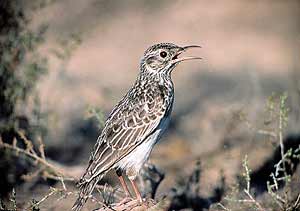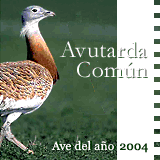Dupont's Lark
 SEO has made Dupont's Lark (Chersophilus duponti) bird of the Year for 2006. SEO has made Dupont's Lark (Chersophilus duponti) bird of the Year for 2006.
Dupont's Lark is a small, shy bird with a curved beak and a characteristic nasal whistle. It inhabits the psuedo-steppes of Central and Eastern Spain, where it is a non-migratory resident, in particular the "páramos" steppe expanses of Castilla and the Ebro Valley in Castilla y León, Castilla-La Mancha, Aragón and Navarra. Its presence in Cataluña, Andalucía, Murcia and Valencia is now considered residual by SEO. Classified as in danger of extinction in Spain, the bird is threatened by changes in land use, particularly the spread of irrigated dry land so we can all have cheap tomatoes in February, reforestation and above all by the growth of wind farms. The 2,000 surviving Spanish pairs represents 100% of the European population, out of a total world population of 13,000-15,000 indviduals -found also in North Africa. Dupont's lark requires flat or almost flat terrain of scrub with cover such as thyme stands, which match its plumage. Its perchant for running between bushes rather than flying makes it a difficult bird to spot. This, in addition to the huge real decline of the bird's population, meant that populations were overestimated in the past.
 Photo of Dupont's lark. Source SEO Alondra Ricotí, elegida Ave del Año 2006 (09/02/06) Photo of Dupont's lark. Source SEO Alondra Ricotí, elegida Ave del Año 2006 (09/02/06)
Dupont's Lark song changes shows habitat break up in Spain and Morocco
"Birds in Spain and Morocco are having trouble hearing and copying each other's songs because of the way their habitat has been broken up, according to a study published today. As a result the birds are living in more isolated groups and only learning songs from their closest neighbours. The researchers believe that these changes in song patterns are an early warning of habitat fragmentation, which could lead to lower genetic diversity and inbred populations. Paola Laiolo and José Tella, of the Estación Biológica de Doñana in Seville, recorded and analysed the songs of a rare and specialised songbird called Dupont's lark, across 21 localities in Spain and Morocco. This lark has particular requirements and can only live in arid scrub steppe. By comparing song similarity between birds, the researchers could show that broken habitats made the male larks mimic their neighbours' songs more than expected, but lose touch with birds on the other side of the habitat break".
"Neighbours shared up to 70% of their phrases, while non-neighbours shared only around 30%," said Dr Laiolo. By contrast birds living in pristine habitat shared around 45% of their phrases with non-neighbours over a similar distance.
The researchers believe that an increase in agricultural land, forest plantations and roads has fragmented the arid steppe habitat, preventing the Dupont's lark from sharing songs over greater distances. "The fragmentation confines the species to smaller areas and eventually the genetic diversity of the population will erode," said Dr Laiolo, whose results are reported in the Journal of Applied Ecology.
Such findings are likely to apply to many kinds of wildlife in a variety of habitats and places. Creatures like insects and small mammals that tend to be less mobile than birds are likely to be hit hardest.
The Guardian (30/11/2005) |
- Wikipedia informs me that the bird was named after the French naturalist Leonard Puech Dupont, who was the first to collect a specimen.
- December 2005's Quercus also had 2 items on dupont's lark:
- Worrying fall of Dupont's lark in Albacete.
- Dupont's lark enclave under threat in Andalusia from windfarms
- Translation: dupont's lark : Alondra Ricotí/Alondra de Dupont (Cast): alosa becuda (Cat): Chersophilus duponti
- Dupont's lark has taken over from Bonell's Eagle as SEO's bird of the year. Read here their conclusions on Bonell's Eagle
Previous birds
 
Here are all of SEO's Birds of the Year
1988 - Black-bellied Sandgrouse (Ganga Ortega)
1990 - Lammergeyer (Quebrantahuesos)
1992 - White Stork (Cigüeña Blanca)
1993 - Lesser Kestrel (Cernícalo Primilla)
1994 - Squacco Heron (Garcilla Cangrejera)
1995 - Bolle's Pigeon (Paloma Turqué) (Endemic to mountain laurel forests of Canaries. Named after German naturalist Carl Bolle was the first to distinguish it from the Laurel Pigeon).
1996 - Common Kingfisher (Martín Pescador)
1997 - Marbled Duck (Cerceta Pardilla)
1998 - Red Kite (Milano Real)
1999 - Capercaillie (Urogallo)
2000 - Spanish Imperial Eagle (Águila Imperial Ibérica)
2001 - Balearic Shearwater (Pardela Balear)
2002 - Red-knobbed Coot (Focha Moruna)
2003 - Common Guillemot (Arao)
2004 – Great Bustard (Avutarda)
2005 – Bonelli's Eagle (Águila Perdicera)
The list offers an interesting hint at habitats and issues in Spain. Surprisingly, no monk (black) vulture.
See also News on Iberian Lynx - News on Birds in Spain - News on Bears in Spain - Wolves in Spain -
alpine accentor - alpine swift - aquatic warbler - arctic skua -arctic tern - Atlantic puffin - Audouin's gull - avocet - azure-winged magpie
-
|
|



